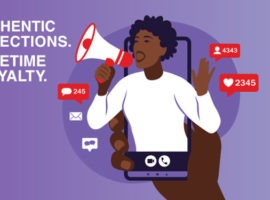How to up your e-commerce game for profitability in 2024
 To improve e-commerce profits, brands need to shift their e-commerce strategy from growth at any cost to one of sustainable revenue.
To improve e-commerce profits, brands need to shift their e-commerce strategy from growth at any cost to one of sustainable revenue.
The notion of bringing B2C-like experiences to B2B buyers in order to succeed has been repeated so often over the last decade that it’s become a bit cliché. In fact, it’s an oversimplification. B2C commerce CX is just as complex as B2B commerce.
Any seasoned business-to-business marketer will tell you that the B2B buying journey is vastly different from a typical consumer’s. More interesting and important is borrowing elements of B2C commerce – search, merchandising, personalization, easy reordering – to create more efficient B2B commerce experiences that are, in turn, more profitable to the seller.
So, if that’s the case, could the reverse be true? Can consumer brands and retailers implement B2B-like functionality to elevate the individual customer experience?
Consciously or not, it’s already happening, and there are still some interesting avenues to explore for future innovation.
 To improve e-commerce profits, brands need to shift their e-commerce strategy from growth at any cost to one of sustainable revenue.
To improve e-commerce profits, brands need to shift their e-commerce strategy from growth at any cost to one of sustainable revenue.
A flavor of this was brought to consumer purchases with the mass adoption of buy-now-pay-later (BNPL) options during the pandemic. Not a new technology at all, BNPL was an overnight sensation almost 20 years in the making, but it demonstrated consumer appetite for more flexible payment options.
Apple is preparing to take this a step further. The company is currently testing 0% long-term financing with their retail employees. When formally rolled out, this will become a payment option at checkout for Apple’s most valuable and loyal customers. Limited to a subset of products purchased directly from Apple, not retail partners, approved customers will be able to carry a no-interest loan for up to 24 months.
This is far more generous for high ticket purchases than the pay-in-four BNPL model, something seen previously only in the automotive sector. It adds value to the customer relationship and will certainly influence conversion.
Look for other premium and luxury brands to adopt similar B2C payment models and reward their best customers with ever more flexible payment options.
 Retailers today need to offer a variety of payment options at checkout. Find out the hot trends, including digital wallets, cryptocurrency, and buy now, pay later.
Retailers today need to offer a variety of payment options at checkout. Find out the hot trends, including digital wallets, cryptocurrency, and buy now, pay later.
B2B purchasing scenarios are often complex. They can consist of separate bill-to, ship-to, sold-to contacts, for instance. The person using a product on the factory floor is often not the person who verifies and approves the order, and the approver is rarely the person who pays for the purchase.
It’s easy to think of numerous ways these account relationships could be applied to families, and some brands already have. “Kids, get your parent’s permission before ordering” has made its way to B2C e-commerce.
Hollister, the teen-oriented apparel brand owned by Abercrombie & Fitch, launched Share2Pay during the 2022 holiday season. This functionality allows Hollister’s target audience to build a cart and then share it directly via text message with a parent or other designated recipient for purchase. The recipient can then review and edit the cart prior to checkout.
This provides a great way for the brand to connect its target audience with those that control the family budget. Yet, this only scratches the surface of what’s possible. Beyond apparel, many sectors can and should adopt this or more complex functionality, including grocery, sporting goods, health & beauty, and electronics.
Allowing families to collectively shop, while managing spend could be the next frontier in customer engagement.
 Does having a customer engagement strategy really matter? Absolutely. Learn how to boost loyalty, drive revenue and build valuable customer relationships.
Does having a customer engagement strategy really matter? Absolutely. Learn how to boost loyalty, drive revenue and build valuable customer relationships.
While the 1:1 pricing common in B2B isn’t feasible for most consumer companies, and consumers rarely buy in bulk quantities, brands can use segmentation to define narrow bands of customers that provide the highest value, and provide them with escalating discounts.
Several factors, including overall spend, frequency of purchase, and even a customer’s propensity to return items, can determine discount tiers. Once unlocked, the customer saves a set amount on every item purchased, less sale items. The lure of bigger discount tiers, encouraged by an array of customer touch points, can encourage further buying behavior.
This is a novel way for B2C commerce brands to go beyond the 80-20 rule and reward their very best customers.
 Customers notice when they're not valued. Retailers should focus on keeping their loyal customers by making digital a priority and delivering omnichannel, personalized customer experience.
Customers notice when they're not valued. Retailers should focus on keeping their loyal customers by making digital a priority and delivering omnichannel, personalized customer experience.
In B2B, portals are the firewalls companies use to allow only authenticated users access to certain resources. This is somewhat mysterious, but can be applied to the consumer space to provide customers with something they all crave: exclusivity.
Separate from a brand’s dot com site(s), these secret, by-invitation-only portals would be reserved for a fraction of customers who meet a predetermined set of criteria that they have to maintain in order to retain access.
Within these sites, fashion brands can unveil new lines or present trunk shows. Footwear brands can provide first-looks and opportunities to purchase new product drops. Retailers can give preferred customers advance access to sale and close-out merchandise. The use cases are many, and the opportunity is large.
It’s clear that B2B commerce can provide utility in the B2C commerce world. A common theme behind many of these concepts is rewarding a brand’s best customers, which are, after all, the most loyal and profitable.